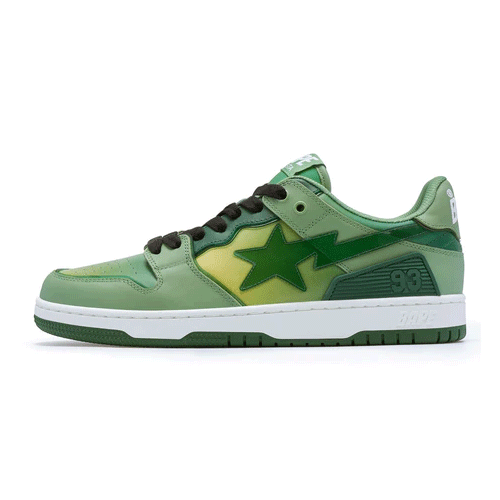When talking about streetwear and sneaker history, certain names instantly stand out—Nike, Adidas, Supreme, and of course, A Bathing Ape, more commonly known as BAPE. Among BAPE’s most recognizable contributions to fashion is the Bapesta sneaker. With its bold design, rich history, and undeniable influence on both hip-hop and sneaker culture, the Bapesta continues to be a cultural force more than two decades after its debut.
The Origins of Bapesta: A Japanese Take on American Streetwear
The Bapesta was first introduced in 2000 by Nigo, the founder of A Bathing Ape. At that time, BAPE was already making waves in Japan’s underground fashion scene, known for its unique graphics, camo prints, and limited-edition drops. However, with the launch of the Bapesta, the brand took its influence to a new level.
Drawing heavy inspiration from Nike’s Air Force 1 silhouette, the Bapesta was a bold reinterpretation rather than a simple knockoff. From afar, the similarities are clear: the shoe’s structure, sole, and shape mirror the AF1. But what set it apart was its design language. Instead of Nike’s iconic Swoosh, the Bapesta features a lightning bolt-like star, now known as the “STA.” The sneaker often came in glossy patent leather finishes and eye-catching colorways that no major U.S. brand dared to try at the time.
In doing so, Nigo wasn’t just copying a popular sneaker—he was reimagining it through a distinct cultural lens. He blended American hip-hop aesthetics with Japanese streetwear ideology, creating a sneaker that was both familiar and revolutionary.
Bapesta and Hip-Hop: A Transpacific Connection
One of the most defining aspects of the Bapesta’s legacy is its close connection to hip-hop. In the early 2000s, American rappers began to take note of BAPE’s outlandish designs and exclusivity. Artists like Pharrell Williams, Kanye West, and Lil Wayne were among the first to embrace the brand. Pharrell, in particular, played a crucial role in introducing BAPE to Western audiences through his music and collaborations.
The Bapesta quickly became a status symbol. Seen on red carpets, in music videos, and on magazine covers, it was a sneaker that screamed individuality. At a time when sneaker culture was still relatively niche outside of core enthusiasts, Bapesta made sneakers fashion statements.
Nigo and Pharrell’s later collaboration on Billionaire Boys Club (BBC) and Ice Cream helped fuse the two fashion worlds further. BBC sneakers also carried a similar design ethos to Bapesta, proving how influential the original concept had become.
Limited Releases and Hype Culture
A huge part of what made the Bapesta special was its exclusivity. Like Supreme, BAPE was one of the early adopters of the “drop” model—limited-edition releases that created immediate hype and long lines outside stores.
Each Bapesta release felt like an event. From camouflage patterns and neon colors to collaborations with cartoon franchises like Marvel, Hello Kitty, and even SpongeBob SquarePants, Bapestas weren’t just shoes—they were collector’s items. Resale values often soared, particularly for rare collaborations, and the demand kept growing.
Today’s hype culture owes much to BAPE’s strategy. Before sneakers were routinely selling out in seconds online, BAPE was already creating scarcity-driven demand, especially through its flagship store in Harajuku, Tokyo.
Design Elements That Define Bapesta
To the untrained eye, a Bapesta might look like just another colorful sneaker, but to enthusiasts, its details tell a story.
The most iconic aspect is the “STA” star logo, an angular, aggressive-looking design that sets it apart from traditional sneaker branding. Many Bapestas are made of patent leather, giving them a glossy, high-fashion appearance. Colorways are often loud—think mismatched tones, primary hues, and metallic finishes.
Additionally, Bapestas sometimes feature BAPE’s signature ABC Camo or bold graphics on the upper. The midsole is embossed with “BAPE” in place of “AIR,” and the outsole is nearly identical to that of the Air Force 1, a design choice that initially stirred legal controversies but has since been accepted as part of the brand’s DNA.
Bapesta Collaborations: A Collector’s Dream
Over the years, BAPE has collaborated with a long list of artists, designers, and brands to create some of the most sought-after Bapestas ever made.
Some of the most iconic collaborations include:
- Kanye West “College Dropout” Bapestas, which featured his bear mascot and album-themed colors.
- Marvel Comics x Bapesta, a line featuring characters like Spider-Man and Iron Man.
- DC Shoes x BAPE, bringing together skate and streetwear culture.
- Undefeated x BAPE, which gave the sneaker a more muted, militaristic feel.
Each collab tells a different story, and many have become holy grails in the resale market. These limited editions not only elevated the status of the Bapesta but helped cement its legacy in pop culture and fashion history.
The Bapesta Today: A Legacy Continues
Despite being over 20 years old, the Bapesta is far from irrelevant. BAPE continues to release new iterations, and the sneaker has recently seen a resurgence thanks to renewed interest in Y2K fashion, nostalgic streetwear, and archival sneaker designs.
Recent years have brought fresh collaborations with brands like Coach, Comme des Garçons, and Adidas, blending BAPE’s streetwear roots with luxury appeal. Even celebrities from the newer generation—such as Lil Uzi Vert, Playboi Carti, and Tyler, The Creator—have been spotted in Bapestas, proving the sneaker’s cross-generational allure.
How to Style Bapestas: From Loud to Laid-Back
One of the reasons Bapestas remain relevant is their versatility in styling. Sure, they’re bold, but that’s part of the charm.
Pairing a colorful Bapesta with neutral tones lets the sneaker take center stage, perfect for streetwear minimalists. On the other hand, full BAPE outfits, including shark hoodies, camo pants, and branded accessories, are still popular among hardcore fans.
Whether you’re aiming for an eye-catching look or a subtle nod to streetwear culture, there’s a Bapesta for every style.
Where Bapesta Stands in Sneaker History
The Bapesta doesn’t just borrow from sneaker culture—it actively shaped it. Before the age of bots, raffles, and resell marketplaces, Bapesta was already turning heads and creating sneaker hysteria. It set the tone for what a limited sneaker drop could be and helped launch streetwear into the fashion mainstream.
Many modern sneaker releases—especially collaborations—owe a nod to BAPE’s strategy of scarcity, storytelling, and style. The Bapesta is more than a shoe; it’s a cultural icon, a design statement, and a piece of history.
Final Thoughts: Why Bapesta Still Matters
In a world of evolving trends, some pieces remain timeless. The Bapesta is one of those rare sneakers that continues to resonate with both OG fans and new collectors. It’s a product of its time, yet endlessly adaptable. As long as streetwear exists—and as long as fashion continues to look backward for inspiration—the Bapesta will have a place in the conversation.
Whether you’re hunting for a vintage pair from the early 2000s or grabbing a recent drop, owning a Bapesta is like holding a piece of sneaker heritage. It’s loud, it’s proud, and it represents everything that makes streetwear a cultural powerhouse.





